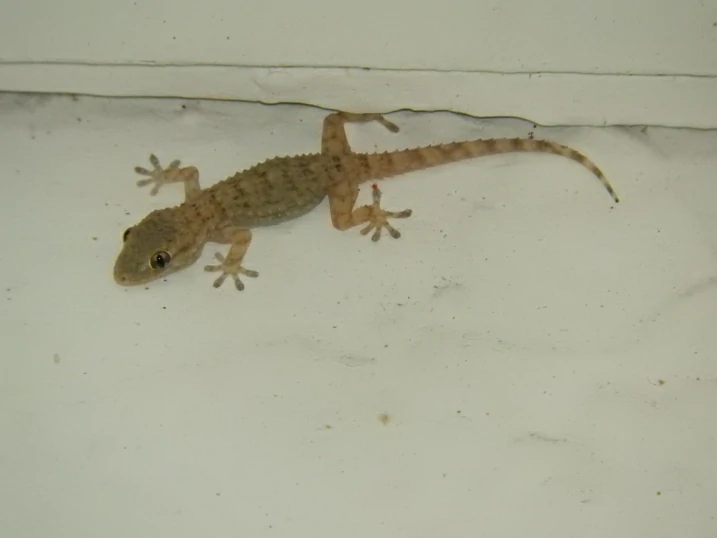If you’ve ever seen a gecko clinging to a ceiling or the underside of a branch, you might have paused and thought, how do they stay there? And why hang upside down at all?
Geckos hang upside down because their toe pads let them stick to surfaces. This gives them access to food, safety, and better spots to watch their surroundings.
It’s not just a fancy trick. Hanging upside down is a key survival skill that helps them hunt insects, escape predators, and move through tricky environments with ease.
The Secret Behind Gecko Clinging
The magic is in their toes. Each gecko toe is covered with tiny hair-like structures called setae. These split into hundreds of even smaller tips called spatulae.
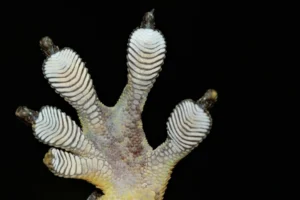
These tiny tips interact with the surface on a molecular level. Basically, they stick because of natural forces at a super small scale.
Even smooth surfaces like glass or polished wood are no problem. No glue, no suction, just physics and biology working together.
How Their Toes Work Like Suction-Free Glue
What makes geckos amazing is their toes stick without being sticky in the usual sense.
They can attach, lift, and move without losing grip. Each step is deliberate: press, stick, lift, repeat.
That’s why you’ll see a gecko hang from a ceiling for minutes or scamper across glass effortlessly. Their feet are perfectly built for an upside-down life.
Why Going Upside Down Helps Them Hunt
Hanging upside down gives geckos a big advantage when hunting.
Many insects crawl along ceilings, the undersides of leaves, or tops of branches to hide from predators. By going where few animals can reach, geckos get access to these hidden meals.
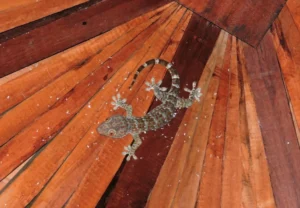
They can spot prey from above, swoop down silently, and grab it at just the right moment. Being upside down also gives them a wider view while staying camouflaged.
Basically, upside-down hunting makes them stealthy, precise, and efficient.
How the Tail Helps While Hanging
A gecko’s tail isn’t just for balance on flat surfaces, it’s important when they hang upside down too.
The tail shifts slightly to counterbalance their body weight. When the gecko stretches or twists, the tail acts like a pendulum, keeping them steady on slippery spots.
If they need to jump to catch an insect or escape, the tail also helps guide the leap.
In short, tail and toes work together like a built-in climbing system.
Being Upside Down Gives Safety From Predators
Upside down isn’t just for hunting, it keeps geckos safe.
Predators like snakes, birds, or small mammals usually hunt along the ground or outer surfaces of trees. By clinging to ceilings, branches, or leaf undersides, geckos stay out of reach.
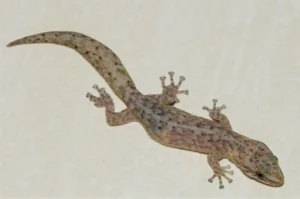
Some hang completely still, blending perfectly with textured surfaces. Being upside down makes it much harder for predators to spot them until it’s too late.
How Geckos Avoid Falling When They Are Upside Down
You might think, shouldn’t gravity make them drop?
Geckos are masters at sticking. The setae on their toes can support many times their body weight. Each toe grips and releases in perfect rhythm.
They also adjust their posture constantly. Tiny muscle shifts keep them stable, even on smooth, angled, or moving surfaces.
That’s why a gecko can walk across a ceiling or cling to glass without slipping.
Do All Geckos Hang Upside Down?
Not all geckos do it the same way.
Tree-dwelling geckos spend most of their time upside down or sideways, moving across branches and leaves. Ground geckos usually stay upright but may climb ceilings if food or shelter is nearby.
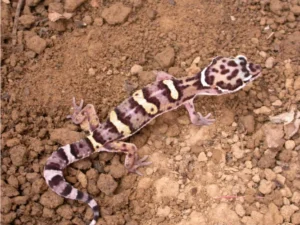
Urban geckos often use walls, windows, and ceilings to hunt insects near lights.
The common factor? Access. Geckos go where food, safety, or the best view exists.
How Baby Geckos Learn to Cling
Young geckos are tiny acrobats from the start.
Even hours after hatching, they can climb walls and hang upside down. Their toe pads work immediately, letting them explore, hunt, and escape predators.
As they grow, they get better coordination and balance. Within weeks, they can leap between leaves or ceilings like adults.
It’s instinct plus natural development, they’re born ready to cling.
How Environmental Surfaces Affect Clinging
Geckos stick to lots of surfaces (leaves, bark, ceilings, even glass) but texture matters.
Rough surfaces give more grip with fewer setae in use. Smooth surfaces rely entirely on tiny molecular forces.
Wet or dusty surfaces can reduce sticking a bit, which is why you’ll see geckos move carefully when it’s slick.
Even so, very few surfaces can completely stop them.
Why Some Geckos Hang for Comfort
Upside down isn’t just for hunting. Geckos also hang to rest safely.
Ceilings and undersides of branches are less exposed to predators and harsh sunlight. Hanging upside down lets geckos sleep, rest, or watch their surroundings while staying hidden.
They often tuck their bodies close to the surface, tail curled, and stay motionless; perfectly camouflaged and secure.
How Hanging Helps With Temperature
Upside-down positions also help geckos stay the right temperature.
Clinging to shaded undersides of leaves or ceilings helps them avoid hot sun. At night, the cooler air above the ground keeps them comfortable while hunting.
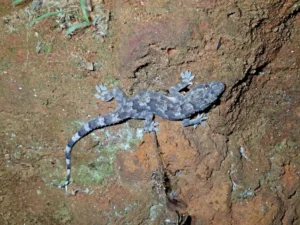
Combined with their nocturnal habits, hanging upside down gives the perfect balance between warmth, shade, and access to food.
Do Geckos Ever Fall?
Sometimes, but rarely.
They might slip if the surface is wet, dusty, or damaged. Most species have reflexes to recover quickly.
Their tails act as stabilizers mid-fall, and they can reattach to a surface in one quick motion.
Even baby geckos survive minor falls with little injury, showing how perfectly they’re built for upside-down living.
How Predators Influence Hanging Behavior
Predators shape when and where geckos hang.
Where birds or snakes are common, geckos prefer higher or more hidden surfaces. In cities, they might hang near walls or ceilings where cats and dogs can’t reach.
This behavior isn’t just instinct, it’s learned. Geckos remember safe spots and go back to them often.
Conclusion
Geckos hang upside down because it’s practical, safe, and efficient.
Their toe pads let them cling easily, their tails keep them steady, and their instincts guide them to food and safety.
Upside-down isn’t a quirk, it’s survival, hunting, balance, and comfort all rolled into one amazing adaptation.
Hi, my name is Ezra Mushala, i have been interested animals all my life. I am the main author and editor here at snakeinformer.com.

